What's Inside a Dingo Systems?
Hardware and Software Used Inside the Tables
Hardware = Computer parts, physical components: motherboard, CPU, Graphics card, hard drives, etc
Software = Operating System (ie, Windows), emulators, programs, frontend, etc
Emulators = Programs that emulate real consoles
Frontend = What the user sees once it’s all running to choose games – Console images, graphics, videos, etc. This is only a visual interface and is not responsible for running any actual emulators or programs.
A quick history lesson…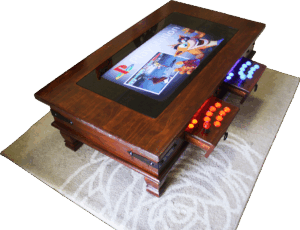
So what’s inside the your tables? In short, I developed my first table in 2014; so let that be a benchmark for the technology available at the time and what the emulators that ran the games required. By modern standards, the hardware in my first table was rather tame. However, in 2014, the hardware used in the tables was considered to be mid-range and adequate for most PC games.
Hardware aside, the software behind it all was on the brink of a revolution of sorts and rather crafty. It’s all run by dozens of independent emulators that simulate each indivual console, which is then played through a graphically illustrative frontend. The frontend aims to not only looks great, but a seemless way to choose the games without the need to open an independent program (usually by mouse and keyboard) – similar to how you would open a word document in an office setting.
Prior to 2014, there were not many options for frontends. Most DIY retro enthusiasts used independent programs or would purchase an expensive “gaming box” such as a Pandora’s Box that used its own specific hardware and installed programs… essentially, a plug-and-play solution. But these all-in-one “game boxes” offered little to no ability for customisations.
In 2014, when I began to make my first table, the development of Rocketlauncher and Hyperspin gave DIY retro enthusiasts the chance to develop their own machines with more freedom and flexibitly. People could now install their own emulators for each individual console, then link them to run through a single program called Rocketlauncher. Not only did this program streamline the operating of each emulator, but also had the ability to change settings, offer fade-in/fade-in splash screens, LED light controls, and dozens more features.
However, with Rocketlauncher, you still required a mouse and keyboard to run it and it didn’t look that great. But at least now everything could be run through a single interface rather than opening programs independently. This is where Hyperspin comes in which worked hand-in-hand with Rocketlauncher by gaving users a graphically illustrative frontend.
Put simply, Hyperspin made things look amazing! It’s a frontend that displayed everything in an easy to use graphical format that can be controlled by a joystick or arcade controller – no need for a keyboard/mouse. Sadly, it took A LOT of know-how to configure which made it difficult for the average retro enthusiast to master. If you where to do it yourself as I did with my Dingo Systems, it took months, if not years, to build and collate all the software, graphics, images, videos and games. But once it was setup, it looked absolutely stunning.
Fast forward to 2025 and now things are easier than ever! With the release of Batocera, users can now simply download the software, copy it to a hard drive (or even USB!), and simply drag and drop games into their respective console folders… that’s it. All the controller configurations, emulator configurations, frontend graphics, images, videos are automatically done for you. The process now only takes you less than 30mins to setup rather than the WEEKS/MONTHS as it took me all those years ago.
However, I still continue to use Rocketlauncher/Hyperspin for my tables as it does offer a lot more customisation that Batocera lacks (implementing niche games like Rockband/Guitar Hero for one). But for the average user, Batocera is certainly the way forward.
Moving on to my first table build:
First Table ~ 2014
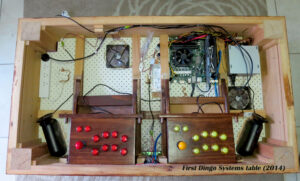
Software:
- Operating System: Windows 7 64bit
- Frontend: Hyperspin (Rocketlauncher)
- Emulators: MAME, Dolphin, Nestopia, Fusion, Visual Boy, Turbo Engine, 4DO, Kawaks, WinUAE, Stella, DEmul, nullDC, Project64, Snes9x, PCSX1
- Consoles (approx 15): Arcade, NeoGeo, 3DO, PlayStation (original), Nintendo Entertainment System, Gameboy, Gameboy Advance, Super Nintendo, Nintendo 64, Atari (2600, 5200, 7800), Sega Master System, Genesis (Mega Drive), Sega 32X, Sega Saturn, Sega Dreamcast
- Games: 10,000
Hardware:
- CPU: i5 2500 | 4 cores 4 threads
- GPU: GTX 550 (upgraded to GTX 660 to handle PS2 games)
- RAM: 4gb DDR3
- Motherboard: H61m
- Hard Drive: 1tb (mechanical hard drive)
- PSU: 450watt
Monitor: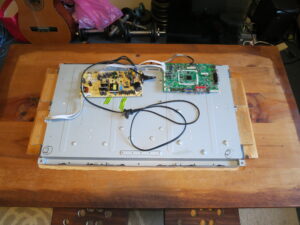
- Screen: 32″ Built-in LCD TV
- Modifications: Back cover removed | Modified placement of internal components
- Alternative Screen: HDMI output to external TV or Monitor.
Accessories:
- Controllers: 2x Custom “Hidden Drawer” 8-button Arcade Controllers | 2x PS3 Controllers (connect via USB)
As of 2025, the retro gaming industry and the demands of the software has evolved greatly. The development of high-end machine emulation for the PlayStation 3, Nintendo Switch, Xbox360, and the oringal Xbox demanded, requires for smooth gameplay a minimum 6-core CPU (Ryzen or Intel) and a GTX 1080ti or above for most 3D based games. Even with these minimums, several emulated games still struggled to maintain a playable 30fps @ 1080p.
While most emulators and retro games can now be play on modern cell phones, demanding PS3, Xbox, Xbox360, and many Switch* emulators still require significant hardware and are not possible to run smoothly or at all on a cellular device (for now).
*Select few Nintendo Switch emulated games are playable on a celular device
While I no longer produce these tables to the general public, my personal table continues to be upgraded to meet the needs of the emerging emulators. However, I have reached a point where I’m comfortable with the gameplay of 99% of the games and may not see an upgrade for the forseeable future; though I’m sure the release of a PS4 emulator WILL require something out of this world by 2025 standards (that emulator is still very much in development, so check back in a few years)
Current Table ~ 2025
Software:
- Operating System: Windows 10 64bit
- Frontend: Hyperspin (Rocketlauncher)
- Emulators: MAME (various), Dolphin, Nestopia, PCSX, Fusion, Visual Boy, Turbo Engine, 4DO, Kawaks, WinUAE, Stella, DEmul, nullDC, Project64, Snes9x, PCSX2, RPCS3, Xenia, Xemu, Ryujinx, Yuzu, Retroarch
- Consoles (approx 40): Arcade, NeoGeo, 3DO, Nintendo Entertainment System, Gameboy, Gameboy Advance, Super Nintendo, Nintendo 64, Atari (2600, 5200, 7800), Sega Master System, Genesis (Mega Drive), Sega 32X, Sega Saturn, Sega Dreamcast, Sega Gamegear, PlayStation, Playstation 2, PlayStation 3, Nintendo Switch, Nintendo Wii, Nintendo WiiU, Xbox (original), Xbox360, PlayStation Portable, Nintendo DS (and 3DS), Nintendo Gamecube, Playstation Vita, TurboGrafx-16, Amiga + Commodore 64, Atari Lynx, Atari Jaguar… various independent PC games, and standalone arcade cabinets (eg, Mario Kart Arcade, Daytona Arcade, etc)
- Games: 10,000+ (Quality over quantity – non working, particially working, double ups, regional variations, mahjong, trashy card games — all have been removed.)
Hardware:
- CPU: i5 11600 @ 4.6ghz | 6 cores 12 threads | AVX512
- GPU: RTX 2070Super
- RAM: 16gb DDR4 @ 3200Mhz
- Motherboard: Z490 WIFI Plus (Bluetooth)
- Hard Drive: 2x Samsung 2tb NVMe 1x 2Tb Samsung SSD (6Tb Total)
- PSU: 750watt 80Plus Rated
Monitor:
- Screen: 32″ Built-in LCD TV
- Modifications: Back cover removed | Modified placement of internal components
- Alternative Screen: HDMI output to external TV or Monitor.
Accessories:
- Controllers: 2x Custom “Hidden Drawer” 8-button Arcade Controllers | 4x PS3 Controllers (connect via Bluetooth or USB)
- Rockband: 2x Rockband guitars, 1x Rockband Drumkit, 1x Microphone
- Lightgun: 2x Wii Remote Lightguns
Noteable Mentions:
My current table is more than just a sitdown cocktail arcade/retro system but has evolved into a more universal entertainment hub. The built-in screen is sadly seldom used these days as I opted for the larger TV screen which the table connects to via a HDMI cable. Furthermore, I’ve added the ability to play more hands-on feature and games such as Guitar Hero, Rockband, Lightgun games and even Karaoke! All of which connect via internal dedicated USB dongle devices or through Bluetooth (less clutter and easy to setup). It’s a real hit for entertaining guests who previous thought none-the-wiser about the coffee table’s hidden secrets.
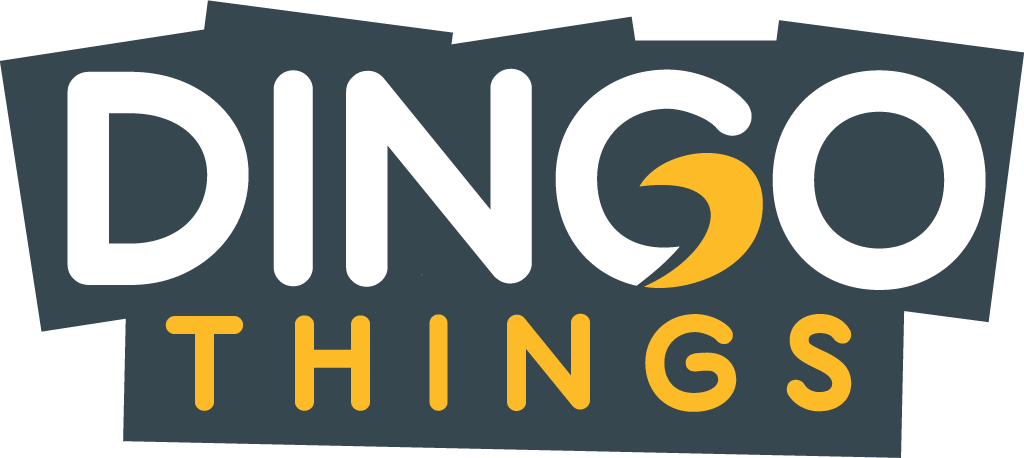
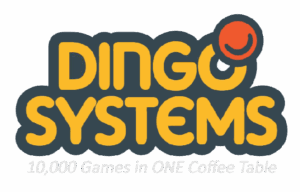
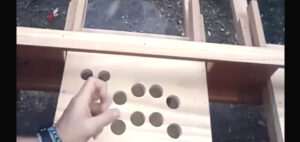
Leave a Reply